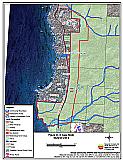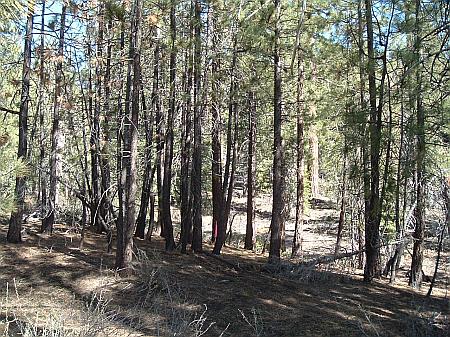Risk/Hazard Identification and Mitigation Project Worksheet
Name of Community: Cave Rock/Skyland
Date: July, 2004
Project Title: Cave Rock/Skyland Unit 2 - Thinning and Brush Removal
Description of Risk/Hazard: Describe in detail the risk or hazard that poses a threat to the community.
Vegetative Fuel and Topography: The tree stand is characterized by a second growth stand of Jeffrey pine with some white fir, incense cedar, and a heavy brush understory of manzanita, tobacco brush, whitethorn, huckleberry oak, bitterbrush, and rabbitbrush. The tree density varies from 80 to 400 sq ft BA/AC.
Priority Ranking: What is the priority ranking of this risk/hazard in relation to all others identified?
This project ranks as #13 priority to the TDFPD.
Location: Describe or attach a map with sufficient detail to allow accurate ground location.
Around the southern portion of the Cave Rock / Skyland Community. See Figure 11-3.
Recommended Mitigation Measures and Scope of Work: Present prescription and work specifications in sufficient detail to facilitate procurement of bids and quotes. For hazardous fuel removal projects include estimated volumes (tons/acre) of fuel removed and disposal plan.
Thin from below, removing smaller trees and leaving larger ones to achieve the desired stocking rate of 80 to 100 square feet of basal area per acre. Remove brush and small trees from beneath the larger trees. Break up the continuity of the brush in open areas by thinning to two times the height of the trees. Remove dead standing trees and down course woody fuels. Remove slash from site or pile and burn. Ground based systems can treat most of the project area south of Lincoln Creek. Brush south of Lincoln Creek could be ground up by a Bull hog.
Thin forest stand from below, removing smaller trees and leaving larger ones to achieve the desired stocking rate of 80 to 100 square feet of basal area per acre. Remove trees heavily infected with dwarf mistletoe.
*Prescribed fire could be used to reduce the brush understory, and desired where feasible to return fire to the landscape. It should only be applied in areas after thinning and slash pile burning are complete to maintain fire control.
Evaluation of the Extent to Which Completion of This Project Will Reduce the Fire Threat:
The project will significantly reduce the chances of a ground fire laddering into the tree crowns. A crown fire burning into the treated area should drop to the ground. If a prescribed fire is run through after treatment, it would reduce the chances of ground or a crown fire moving through the area.
If all of the recommendations in this report are implemented, there is still no guarantee that a devastating wildfire will not occur in the area. However, community awareness and individual attention to fuels management on private property and fuel reduction on state, federal, and county property will help to achieve the highest level of wildfire safety possible.
Identification of Protected Species or Other Critical Resources: Describe any measures that must be taken to protect critical wildlife habitat, historic
Environmental compliance measures must be implemented before project initiation. Stream Environment Zones are located in the project area and must be protected, employing appropriate TRPA mitigation measures.
Some threatened and endangered species exist in the Tahoe Basin. Appropriate avoidance and mitigation measures should be employed during project implementation.
Compliance with cultural resource protection may also be necessary. Check with TRPA and the NVSHPO to ensure cultural resources are protected.
Post-project Rehabilitation: Present scope of work in sufficient detail to facilitate procurement of bids and quotes.
Rehabilitate and revegetated any roads or equipment landings used during the project.
Estimated Timeline:
Desirable time of year to complete:
Mechanical: May - December
Hand: April - December
Estimated time required to complete project:
Mechanical harvesting could be completed in one operational season. The area north of Lincoln Creek could take three years to complete by hand.
Estimated Cost: Present an estimate of the total cost of project completion and the basis for the estimate presented. If the project can be subdivided into phases or various components, present an estimated cost for each.
Cable yarding is recommended, however, no costs for cable yarding were available. The costs below are a minimum based on currently accepted methods in the Tahoe Basin.
| Hand cut, pile, and burn | $2,000 / acre X 203 acres | |
| Prescribed fire within 5 years | $1,600 / acre X 203 acres | |
| Total Cost | $ 649,600 |
Project Maintenance Requirements:
Thinning or prescribed fire at 10 year intervals to control growth of brush and young trees.
Other Considerations: Describe any other considerations that must be taken into account to successfully complete this project such as permits, clearances, approvals, etc.
- USFS - Approval (EA, T&&E, Cultural)
- TRPA Approval (EA, SEZ, T&&E, Cultural, THP)
- Air Quality
- State (NDF) Timber Harvest permit and stream zone variance
Figure 11-3Proposed Prescription Area Cave Rock / Skyland Unit 2 |
 |

